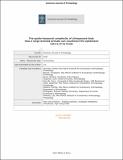Files in this item
Spatio-temporal complexity of chimpanzee food: how cognitive adaptations can counteract the ephemeral nature of ripe fruit
Item metadata
| dc.contributor.author | Janmaat, Karline Rozemarijn Lysbeth | |
| dc.contributor.author | Boesch, Christophe | |
| dc.contributor.author | Byrne, Richard William | |
| dc.contributor.author | Chapman, Colin A | |
| dc.contributor.author | Gone Bi, Zorro B | |
| dc.contributor.author | Head, Josephine S | |
| dc.contributor.author | Robbins, Martha M | |
| dc.contributor.author | Wrangham, Richard W | |
| dc.contributor.author | Polansky, Leo | |
| dc.date.accessioned | 2017-01-22T00:32:17Z | |
| dc.date.available | 2017-01-22T00:32:17Z | |
| dc.date.issued | 2016-06 | |
| dc.identifier | 240125625 | |
| dc.identifier | 7315ff86-04aa-4e00-b1f8-0c220bbae029 | |
| dc.identifier | 84958078268 | |
| dc.identifier | 000376992100003 | |
| dc.identifier.citation | Janmaat , K R L , Boesch , C , Byrne , R W , Chapman , C A , Gone Bi , Z B , Head , J S , Robbins , M M , Wrangham , R W & Polansky , L 2016 , ' Spatio-temporal complexity of chimpanzee food: how cognitive adaptations can counteract the ephemeral nature of ripe fruit ' , American Journal of Primatology , vol. 78 , no. 6 , pp. 626-645 . https://doi.org/10.1002/ajp.22527 | en |
| dc.identifier.issn | 0275-2565 | |
| dc.identifier.other | ORCID: /0000-0001-9862-9373/work/60630560 | |
| dc.identifier.uri | https://hdl.handle.net/10023/10145 | |
| dc.description | Funding to CC for research in Kanyawara was provided by the Canada Research Chairs Program, Natural Science and Engineering Research Council of Canada, Fonds Québécois de la Recherche sur la Nature et les Technologies, Wildlife Conservation Society, Canadian Foundation for Innovation, Killam Foundation, Primate Conservation Inc., Morris Animal Fund, Leakey Foundation, Ford Foundation, McGill University, National Geographic Society, and by NIH grant TW009237 as part of the joint NIH-NSF Ecology of Infectious Disease program and the UK Economic and Social Research Council. Funding for research in Taï was funded by the Max Planck Institute for Evolutionary Anthropology. For Loango funding was provided by the Max Planck Society, Mr Romout Swanbourn, the US Fish and Wildlife Service and BHP Billiton. | en |
| dc.description.abstract | Ecological complexity has been proposed to play a crucial role in primate brain-size evolution. However, detailed quantification of ecological complexity is still limited. Here we assess the spatio-temporal distribution of tropical fruits and young leaves, two primary chimpanzee (Pan troglodytes) foods, focusing on the predictability of their availability in individual trees. Using up to 20 years of information on monthly availability of young leaf, unripe and ripe fruit in plant species consumed by chimpanzees from tropical forests in East, Central, and West Africa, we estimated: (1) the forest-wide frequency of occurrence of each food type and (2) the predictability of finding ripe fruit-bearing trees, focusing on the timing, frequency, and amount of ripe fruit present. In all three forests, at least half of all encountered trees belonged to species that chimpanzees were known to feed on. However, the proportion of these trees bearing young leaves and fruit fluctuated widely between months. Ripe fruit was the most ephemeral food source, and trees that had more than half of their crown filled were at least nine times scarcer than other trees. In old growth forests only one large ripe fruit crop was on average encountered per 10 km. High levels of inter-individual variation in the number of months that fruit was present existed, and in some extreme cases individuals bore ripe fruit more than seven times as often as conspecifics. Some species showed substantially less variation in such ripe fruit production frequencies and fruit quantity than others. We hypothesize that chimpanzees employ a suite of cognitive mechanisms, including abilities to: (1) generalize or classify food trees; (2) remember the relative metrics of quantity and frequency of fruit production across years; and (3) flexibly plan return times to feeding trees to optimize high-energy food consumption in individual trees, and efficient travel between them. | |
| dc.format.extent | 20 | |
| dc.format.extent | 2079983 | |
| dc.language.iso | eng | |
| dc.relation.ispartof | American Journal of Primatology | en |
| dc.subject | Brain size evolution | en |
| dc.subject | Foraging cognition | en |
| dc.subject | Cognitive movement | en |
| dc.subject | Tropical rainforest fruit | en |
| dc.subject | Ecological intelligence | en |
| dc.subject | High-energy food | en |
| dc.subject | QL Zoology | en |
| dc.subject | BF Psychology | en |
| dc.subject | NDAS | en |
| dc.subject.lcc | QL | en |
| dc.subject.lcc | BF | en |
| dc.title | Spatio-temporal complexity of chimpanzee food: how cognitive adaptations can counteract the ephemeral nature of ripe fruit | en |
| dc.type | Journal article | en |
| dc.contributor.institution | University of St Andrews. School of Psychology and Neuroscience | en |
| dc.identifier.doi | 10.1002/ajp.22527 | |
| dc.description.status | Peer reviewed | en |
| dc.date.embargoedUntil | 2017-01-21 |
This item appears in the following Collection(s)
Items in the St Andrews Research Repository are protected by copyright, with all rights reserved, unless otherwise indicated.

